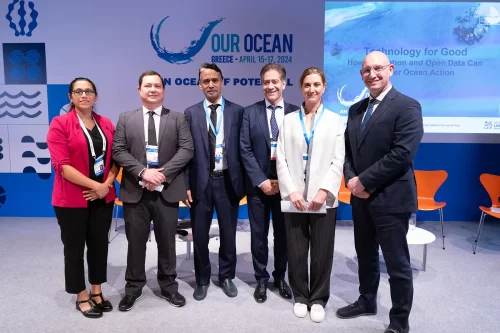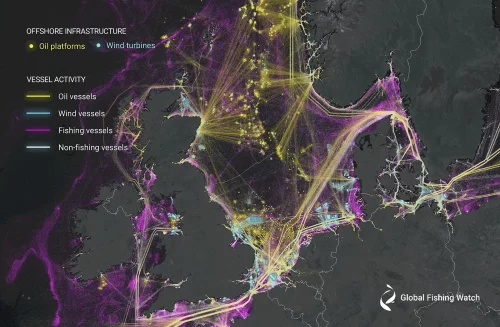Fishing for tuna into daylight hours increases dangers for iconic seabirds, presents opportunity for better management
The biggest threat albatrosses face at sea is being caught and killed on commercial fishing hooks as they target bait for food. New research shows tuna longline fishing vessels deploy millions of hooks at the worst time of day for these threatened seabirds–when they are most actively searching for prey.
In new research published today in Biological Conservation, partners Global Fishing Watch and Birdlife International use GPS data to show most tuna longline vessels operating in albatross habitat set their lines just before sunrise and continue into the early morning hours. This spans the time when albatrosses are feeding and are most vulnerable to being caught on hooks as they search for food.
Monitoring high seas fisheries is extremely challenging due to their distance from shore and the extended periods of time vessels spend at sea, with some not returning to port for many months. This innovative research applied machine learning to process billions of GPS locations from longline vessels to identify when vessels are deploying their hooks.
“Harnessing satellite data in this way revealed the vast global footprint of longline fishing,” said David Kroodsma, director of research and innovation at Global Fishing Watch. “It also allows us to better understand when these vessels are setting their lines, providing a new management tool to help reduce risks to endangered seabirds.”
This method can be used by fisheries managers and independent organizations to better understand the activity of longline fleets and monitor the implementation of management measures aimed at reducing impacts on endangered species, including albatross.
“Albatross populations are tragically in steep decline, with tens of thousands of birds per year killed by fisheries,” said Oliver Yates, head of the BirdLife International Marine Programme. “This bycatch is completely avoidable, and setting hooks at night is one of the simplest and most effective measures. This study shines an important light on fishing during the darkness.”
Global tuna fisheries management organizations developed recommendations to reduce accidental catch of other species, known as bycatch. This includes measures to protect albatrosses, of which fifteen of the twenty-two species are currently threatened with extinction. One of these recommendations is to set longlines entirely at night when albatrosses are not active.
The scale of longlining–a fishing technique that uses main lines with baited hooks–is hard to fathom. Each longline vessel lets out a fishing line extending up to 100 kilometers across the ocean, with thousands of hooks attached. These lines are so long that vessels often set them in the same direction, at the same time to avoid tangling. Every day, over 1000 longline vessels set fishing lines to catch tuna and other large oceanic fish and sharks–this equates to billions of hooks set across the globe annually.
Although bait is a relatively easy meal for an albatross, it sometimes becomes their last, as they become caught on the hook and drown as the hook sinks into the water. This research highlights the need for tuna longline vessels to modify their fishing behavior to reduce bycatch of albatross species already under threat of extinction.
Notes to the editor:
- Supporting graphic: here.
- Graphic caption: Global longline sets that occurred during twilight and daylight hours over the time period analyzed, from 2017 through 2020. Bounding boxes represent regions where tuna regional fisheries management organizations recommend setting at night to avoid seabird bycatch.

